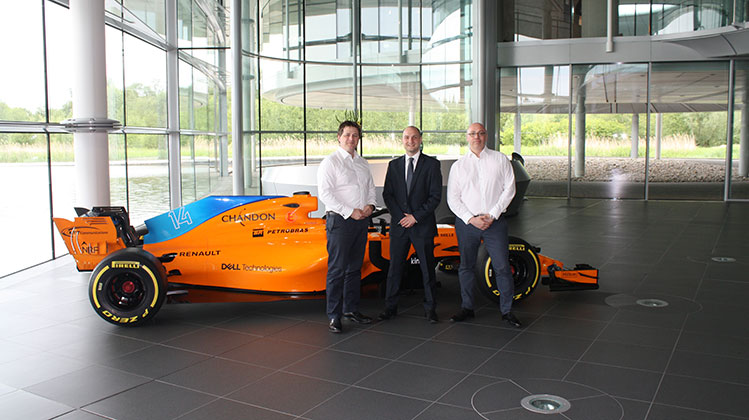An interview with Jim Newton, Global Market Development Director, McLaren Applied Technologies, and Martin Bowman, Director, Aviation Technology, Deloitte. By Ryan Ghee

Jim Newton, Global Market Development Director, McLaren Applied Technologies; Airport Business’ Ryan Ghee; and Martin Bowman, Director, Aviation Technology, Deloitte.
What can the air transport industry learn from Formula 1? Well, the simple answer is: far more than you might ever have imagined. A year on from the announcement of a collaboration between McLaren Applied Technologies and Deloitte, who have teamed up to build data-driven business products for a variety of industries, Airport Business paid a visit to the McLaren Technology Centre in Woking, UK to find out how this unique relationship can benefit airports, airlines and their partners.
McLaren, which is best known for its Formula 1 and automotive businesses, is keen to share its expertise in engineering, design, sensors, simulations, data and analytics to help organisations in other verticals realise efficiencies and enhance operational performance.
“We’re particularly focusing on where there’s a dynamic environment, a constantly changing picture and where there are people within businesses that have to tackle the task of understanding that picture, see the way forward, and make the right operational decisions,” explained Jim Newton, Global Market Development Director, McLaren Applied Technologies. “This is all about helping people make better decisions more often and using technology to support that decision-making process.”
Martin Bowman, Director, Aviation Technology, Deloitte, added: “We felt there must be potential for this within aviation. Aviation is a very dynamic industry, but it’s not always the most joined-up. Organisations tend to exist in data siloes, when actually there is a lot of potential if this can feed into a central hub and provide a bigger picture. The ability to use these technologies to run millions of simulations, often in real time, in order to take a data-driven approach to making decisions will allow a step-change in thinking.”
To date, McLaren Applied Technologies and Deloitte have created three proof of concepts for products, two of which are for stakeholders in the air transport sector. The collaboration has grabbed attention partly because of the intriguing parallels between F1 and aviation. “You have to manage and navigate your way through a Formula 1 race, just as you have to manage and navigate your way through the day at an airport to reach the best possible outcome. Each industry is highly regulated, the rules change on a continual basis and they’re both safety critical,” said Newton.
The benefits of a closed loop system
Newton explained that the McLaren Formula 1 team reaps the benefits of a “closed loop system” in which the window between races – which can be as little as one week – is used to analyse the latest performance using data tools, identify what could have been done better, and rapidly implement upgrades.
“It’s fair to say in aviation there isn’t a closed loop system,” Bowman explained. “There isn’t a formal review process where we analyse what happened, and whether any different decisions would have driven a better outcome. Therefore, we don’t feed that back into the process so that when the event happens again in future, we are delivering with the best possible outcome in mind.”
Both Newton and Bowman suggested that in order for the air transport industry to achieve meaningful change, a shift in mindset is necessary. One area that this applies to is how to make use of the vast amount of data available. “People talk a lot about big data; we prefer small, important data, and the right data,” Newton stated.
In order to realise the potential offered by engineering, sensors, simulations, data and analytics, greater collaboration between air transport industry stakeholders is essential, Newton added. “There’s only so far this industry, or any other industry, can go by optimising things on individual bases. The next big step in performance is probably available where those previously separate worlds start working together, sharing performance data and ways of working in a much more open and collaborative manner. That should be good for everyone, right through to the passenger.”







